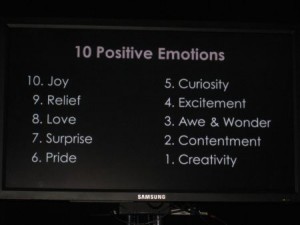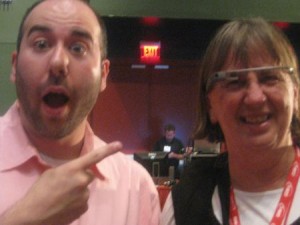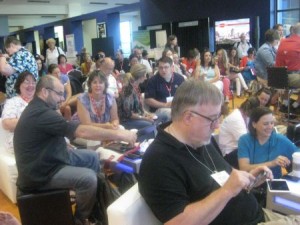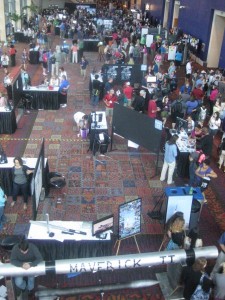Guest Blogger – Anne Mirtschin
The 2013 ISTE conference #iste13 was held in June in beautiful San Antonio, USA. The following statistics give some idea of the size of this conference:-
- 13,100 registered participants representing 74 countries with 1855 international attendees
- 373 virtual participants using Access ISTE and
- 4500 exhibitor personnel showcasing the latest in ed tech from 49 companies
- 1,100 presenters
- More than half a million pieces of digital content were created during ISTE 2013
Its sheer magnitude meant that this conference can exemplify an ‘innovative and ideal’ classroom. Customized learning, catering for differing learning styles eg choices of lectures, hands on, networking, interaction, conversations, small groups, peer to peer, virtual can take place. Personal choice over the best space for learning – from lounges, cafes, ballrooms, formal classroom settings to quiet reflective spaces were provided. BYOD (Bring Your Own Device) was evident with every conceivable mobile device being used by attendees. There were doctors in the house for technical problems. Short concentration spans were catered for by IGNITE sessions where there is a high turnover of presenters and topics within the hour. Play time was allowed for in the numerous Playgrounds, Learning Station sessions on offer etc.
Th e keynotes set the scene for the conference. Two notable ones included the opening keynote with a leading speaker on games and the application of game-design to education, Jane Mcgonigal – Learning is an Epic Win and the closing keynote by popular perennial ISTE presenter, Adam Bellow – You Are Invited To Change the World. Jane mentioned the 10 positive emotions of playing games (see image below) and shared some highly successful social games that included Evoke and Find the Future – game to encourage the young people back into the State Library of New York.
e keynotes set the scene for the conference. Two notable ones included the opening keynote with a leading speaker on games and the application of game-design to education, Jane Mcgonigal – Learning is an Epic Win and the closing keynote by popular perennial ISTE presenter, Adam Bellow – You Are Invited To Change the World. Jane mentioned the 10 positive emotions of playing games (see image below) and shared some highly successful social games that included Evoke and Find the Future – game to encourage the young people back into the State Library of New York.
The trending themes/topics this year (from my perspective) were:
- Games in Learning or Gamification of Learning

- Mobile Learning
- MOOCS
- Transmedia storytelling
- Augmented Reality
- Flipped Classroom
- Google glass
Some of the trending tools and apps included:
- educlipper, scoopit for curating
- aurasma – augmented reality
- Padlet – multimedia walls See a great example Tools To Power Up Your Teaching
- qrphroria – decorative QR codes
- delivr.com – a QR code generator – which is editable over time
- faturl – share up to 10 url links at once
- vine app – create short, simple digital videos to share
- popcorn maker – interactive videos or read write videos
- thinglink and thinglink app – interactive images
My favourite learning spaces included the Bloggers Café, the Interactive Playgrounds (interactive videoconferencing, mobile learning, digital storytelling, digital media) and the Learning (Poster). Sessions where I could interact, network, ask questions, learn on a personal basis, share conversations and enjoy ‘hands on’ activities with mentors, experts and fellow teachers. Other favourite sessions included:
- Twitter 201: Build Your PLN with Advanced Tips and Tools,
- Global Education Summit, Your School Library – Mobile, Flipped and Curated and
- From Angry Birds to Minecraft – What Games Teach us about Learning.

Networking is an important element of attending a conference and there is something very special about being in the Bloggers Café, sharing conversations with many people who are brought to Australia as keynote speakers, meeting a professional network face to face and making many new friends etc. I was proud to be able to share personal involvement in global education at the Global Education Summit Global Projects for Beginners and the Flat Classroom Learning Sessions, Birds of a Feather “Global Education in the Flat Classroom” gathering and the #flatiste13 Spotlight presentation “Do You Co-create at the elementary level – Flat Classrooms Do.”
There was a strong contingent of Australian educators present and on many occasions I would mentally compare education in Australia, particularly Victoria, with that in other countries. It is always satisfying to note that teachers in Victoria have high and ready access to technology; the teacher laptop program; the EduSTAR image for staff and students, a 1:1 policy amongst many schools and a supportive DEECD Digital Learning division with a commitment to embrace immerse technology in innovative and ‘cutting edge’ ways. Many of our teachers are using technology at the leading edge, sharing their work online and all Victorian teachers have ready access to blogging campuses, virtual classroom and conferencing software. This sets us on a par (or at the lead) with the most other countries. Centres like Quantum Victoria are at the forefront of innovation in using robotics, 3D printing, games based learning etc.
The work of our Victorian Virtual Learning and the Virtual Wimmera School is commendable. Many rural and remote schools in the USA have videoconferencing facilities. These are used to provide access to specialist subjects, expert speakers, virtual excursions etc. There did not appear to be a centralized distance learning centre with a teacher and subject base. In Victoria, most rural schools have been provided with videoconferencing equipment. There are many districts in the USA where classroom access to computers and technology is sadly lacking. The emphasis on data driven learning is of high concern to many US educators (as it is with many of our Australian educators).
Attending ISTE13 was a great opportunity, providing many networking opportunities, exposure to the latest trends in learning, technological devices, cutting edge thinking etc. Learning at ISTE13 was the theme of this week’s Tech Talk Tuesday webinar. Listen to the recording 



July 17, 2013 at 7:47 am
Fantastic post Anne…..so inspirational being able to immerse yourself in an environment like that for a few days. Thanks for sharing and looking forward to hearing more about it as you reflect over the coming months.
I’ve just returned from Qatar for the International iEARN conference. We had a party of 10 teachers this year and all were inspired by the range of global collaborative opportunities that exist throughout the world and the sense of humanity that only comes comes from authentic experiences such as these.
Pingback: 3d Qr Generator Pro Software | 7Wins.eu